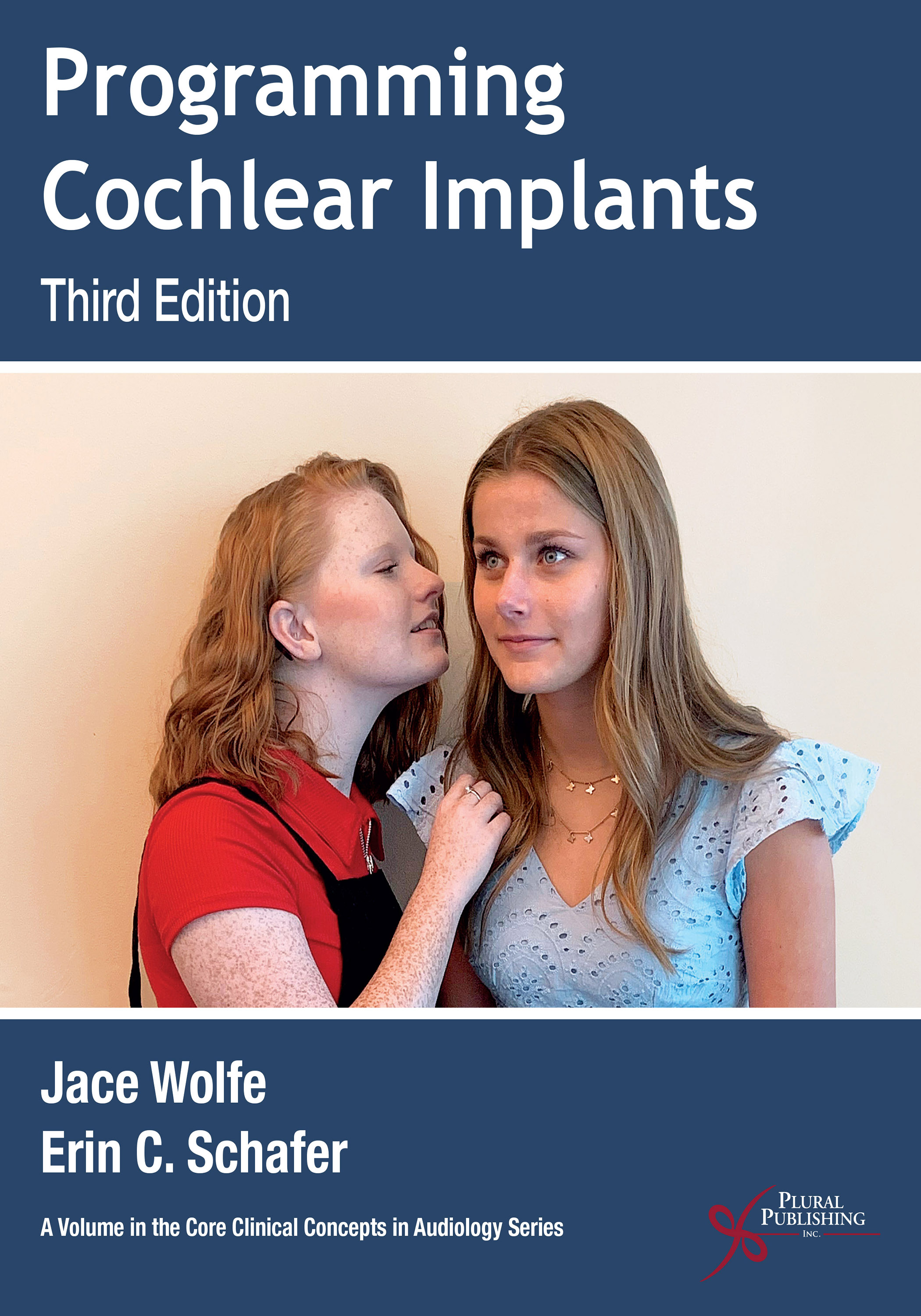
Programming Cochlear Implants
Third Edition
Jace Wolfe, Erin C. Schafer
Details: 630 pages, 2-Color, Softcover, 8.5" x 11"
ISBN13: 978-1-63550-176-6
© 2024 | Available
For Instructors
Purchase
Cochlear implants offer significant benefits for children and adults with severe to profound hearing loss; however, to realize these benefits, the device must be carefully and correctly programmed. With current information on cochlear implant technology, Programming Cochlear Implants, Third Edition, a volume in the Core Clinical Concepts in Audiology Series, is a valuable guide for clinicians providing services to cochlear implant users or as a teaching tool for graduate-level students
Programming Cochlear Implants, Third Edition introduces the basics of cochlear implant hardware and programming and continues through advanced programming techniques, with manufacturer-specific information and case studies. The text reviews clinical protocols for cochlear implant management; programming considerations for bilateral cochlear implant; troubleshooting during the programming process; device-specific programming techniques; use of objective measures to set cochlear implant programs; use of assistive listening devices with cochlear implants; and providing support to difficult-to-program users, such as infants, individuals with cognitive impairment, persons with disabilities, and so forth.
New to the Third Edition
- The latest hardware innovations in modern cochlear implant systems
- Advancements in software and programming approaches for cochlear implants
- New content on methods used to code sound intensity in cochlear implant systems
- Updates on the latest signal processing and input processing schemes and technologies used in cochlear implants
- Expanded discussion of programming considerations related to electric-acoustic stimulation and bimodal use
- Recent developments in hearing assistive technologies used by cochlear implant recipients
- New and updated information on objective measures in cochlear implant programming
Contents
Preface
Introduction
Acknowledgments
Contributors
Chapter 1. Basic Components and Terminology of a Cochlear Implant
Jace Wolfe and Erin C. Schafer
Basic Operation of Cochlear Implants
Basic Components of Current Cochlear Implant Systems
Basic Terminology of Cochlear Implant Programming
Parameters Affecting Signal Coding in the Intensity Domain
Stimulation Levels
Threshold of Stimulation
Upper Stimulation Levels
Current Amplitude and Pulse Width
Mapping Acoustic Inputs Into the Electrical Dynamic Range
Parameters Affecting Signal Coding in the Frequency Domain
Electrode Contact Versus Channel
Virtual Electrodes (Current Steering)
Frequency Allocation
Parameters Affecting Signal Coding in the Time Domain
Stimulation Rate
Basic Cochlear Implant Terminology
Electrode Coupling Strategy/Stimulation Mode
Sequential Versus Simultaneous Stimulation
Interpolation
Sweeping
Loudness Balancing
Radio Frequency
Telemetry
Impedance
Voltage Compliance
Mixing Ratio
Basic Cochlear Implant Signal Coding Strategies
Continuous Interleaved Sampling
HiResolution Sound Processing
n-of-m Strategies
Spectral Peak (SPEAK)
Advanced Combination Encoder
Fine Structure Processing
Simultaneous Analog Stimulation
Intensity Coding in Cochlear Implants
Intensity Coding in Advanced Bionics Cochlear Implants
Input Dynamic Range
Automatic Gain Control–2
Effect of T and M Levels on Intensity Coding
Volume Control
Sensitivity
Channel Gain
Intensity Coding in Nucleus Cochlear Implants
Input Dynamic Range, Instantaneous Input Dynamic Range, T-SPL, C-SPL, Automatic Gain Control, Sensitivity, and Autosensitivity Control
Volume Control
Intensity Coding in MED-EL Cochlear Implants
Input Dynamic Range, Electrical Dynamic Range, and Adaptive Sound Window
Dual-Loop Automatic Gain Control
Maplaw
Key Concepts
Chapter 2. Basic Principles of Programming
Jace Wolfe and Erin C. Schafer
Preactivation Procedures
Realistic Expectations Prior to Activation
Reviewing Logistics of Cochlear Implantation
Familiarity With Cochlear Implant Hardware
Setting the Stage
Programming After Implantation
Physical Evaluation
Selecting a Signal Coding Strategy
Streamlined Versus Comprehensive Programming
Measuring Stimulation Levels
Setting Threshold Levels for Adults
Special Considerations for Setting Threshold Levels for Children
Additional Measure to Ensure Adequate T Levels and Confirm Audibility
Setting Upper Stimulation Levels for Adults
Setting Upper Stimulation Levels for Children
Additional Considerations in the Measurement of Stimulation Levels
Adjustments to Special Parameters
Stimulation Rate
Pulse Width
Channel Gain
Frequency Allocation
Input Dynamic Range
Maxima
Key Concepts
Chapter 3. Advanced Bionics Hardware
Jace Wolfe and Erin C. Schafer
Advanced Bionics Sound Processors
Naída CI Marvel and Sky CI Marvel Sound Processors
Sound Processor Microphones
Digital Signal Processing
Processor Controls
Marvel CI M AquaMic
Naída Marvel CI LED Light and Internal Alarms
Naída CI Marvel Connectivity
AutoSense OS 3.0
Phonak Link Hearing Aid and Adaptive Phonak Digital Bimodal Fitting Formula
Adaptive Phonak Digital Bimodal Fitting Formula
Advanced Bionics AB Remote App
Advanced Bionics Chorus Sound Processor
Advanced Bionics Universal and AquaMic Headpieces
Naída CI Q Sound Processors
Naída CI Q Battery Module
Neptune Sound Processor
Advanced Bionics Internal Hardware
HiRes Ultra Cochlear Implant
Mid-Scala Electrode Array
HiFocus SlimJ Electrode Array
HiRes 90K Advantage Cochlear Implant
HiRes 90K Implantable Cochlear Implant
Key Concepts
Chapter 4. Programming Advanced Bionics Implants
Jace Wolfe and Erin C. Schafer
Advanced Bionics Programming Interface
Advanced Bionics CI Target Programming Software
Step 1: Client Section—Enter Patient and Implant Information/Telemetry Measures
Home Page and Training Mode
Workspace Tabs
Implant Settings
Audiogram
Step 2: Instruments Section
Impedance Measurement
Fitting Section
Mapping
Signal Coding Strategy
Pulse Width and Stimulation Rate
Filter Type
Radio-Frequency Lock
Step 3: Setting Stimulation Levels
Maps Versus Programs in Target CI Software
Creating Multiple Maps
Fine-Tuning
Programs
Manual Programs
Additional Considerations for AutoSense OS 3.0 and Manual Programs
Span
Progressive Levels
Program Manager
Maps and Programs in the Marvel Sound Processor
Bilateral Maps
Data Logging
Device Options
Save and Close
Presenting Programming Stimuli
Measuring T Levels
Measuring M-Level Stimulation
Electroacoustic Stimulation—Marvel Acoustic Earhook
Programming Advanced Bionics Bimodal Recipients in Target CI
Advanced Bionics Active Insertion Monitoring System
Programming in Advanced Bionics SoundWave Software
Step 1: Create or Select Recipient
Step 2: Connect Sound Processor and Conduct Electrode Impedance Measurement
Step 3: Create a MAP in the SoundWave Software
Select Sound Processing Strategy
Pulse Width and Stimulation Rates
ClearVoice
SoftVoice
Stimulus Units and Measuring T Levels
Measuring M-Level Stimulation
Channel Clipping and Span
Input Dynamic Range and Automatic Gain Control
Microphone Sensitivity
Lock
Extended Filtering
Channel Gains
Load MAPs Onto Sound Processor as User Programs
DuoPhone
ZoomControl
StereoZoom
Mic Mode
WindBlock, SoundRelax, EchoBlock
Audio-Mixing Ratio
Internal Telecoil
Volume Minimum and Volume Maximum
DirectTouch
Clear Slot and Stimulate
Audible Alarms and QuickSync
Additional User Options
Loading Programs Into Advanced Bionics Sound Processors
Data Logging
Ground (Return/Reference) Electrode
Key Concepts
Chapter 5. Cochlear Nucleus Cochlear Implants and Sound Processors
Jace Wolfe and Erin C. Schafer
Introduction
Nucleus Sound Processors
Nucleus 7 Sound Processor
Nucleus 7 Features
Nucleus 7 Microphone Technology
Nucleus 7 Electronics
Nucleus 7 User Options
Nucleus 7 Acoustic Component
Nucleus 7 Accessories
Nucleus 7 Wearing Options
Nucleus 8 Sound Processor
Nucleus Kanso 2 Sound Processor
Nucleus Kanso 2 Microphones
Nucleus Kanso 2 Electronics
Nucleus Kanso 2 Wearing Options
Nucleus Kanso Sound Processor
Nucleus Kanso Microphones
Nucleus Kanso Electronics
Nucleus Kanso Wearing Options
Nucleus 6 Sound Processor
Wearing Options
Battery Options
Processor Buttons and Lights
Processor Direct Auditory Input Port
Wireless Remote Assistants
Nucleus Cochlear Implants
The Nucleus Profile Cochlear Implant
Nucleus Profile Plus Cochlear Implant
Nucleus Freedom Internal Device
Nucleus Electrode Arrays
Nucleus Slim Modiolar Electrode
Nucleus Contour Advance Electrode
Nucleus Slim Straight Electrode
Nucleus Slim 20
Nucleus Straight Electrode Array
Nucleus Double Array
Nucleus L24 Hybrid Electrode Array
Nucleus Slim 20 Electrode Array
Key Concepts
Chapter 6. Programming Nucleus Cochlear Implants
Jace Wolfe and Erin C. Schafer
Programming Nucleus Implants
Programming Nucleus Sound Processors
Creating Recipient Files
The Programming Process
Dashboard
Measure
Impedances
Transimpedance Matrix Measurement
AutoNRT
Adjust
Opening or Creating MAP
Master Volume
Four Options for Creating New MAPs in Custom Sound Pro
AutoNRT
Population Mean
Other Measures
Thresholds
Initial Activation in Custom Sound Pro
Custom Sound Pro—Follow-Up Programming Sessions
Parameters
Strategy
Stimulation Mode
Channel Rate (Hz)
Maxima
Pulse Width (Microseconds)
Power Level Setting
Tone Level (%DR), Tone Channel, Low Tone Channel
Volume Adjustment
Manufacturer’s Settings
Frequency Table
T-SPL and C-SPL
Loudness Growth
Set Levels Screen
Adjusting Default Parameters
Determining Stimulation Levels for Nucleus Cochlear Implants
Optimizing T Levels
Optimizing C Levels
Optimizing the Electrical Dynamic Range
Channel Gains
Voltage Compliance
Prediction of Stimulation Levels From Other Programs
Progressive MAPs
Double-Channel Mapping
Channel-to-Electrode Assignment
Finalize
Adjust and Configure Programs and Input Processing
Input Processing
Nucleus Input Processing Technologies and Considerations for Use
Autosensitivity Control and Autosensitivity Control Breakpoint
Adaptive Dynamic Range Optimization
Beam and Focus
Zoom
Forward Focus
SCAN
SCAN 2
SCAN 2 FF
SNR-NR—Signal-to-Noise Ratio–Noise Reduction
WNR – Wind Noise Reduction
Whisper
Processor Settings
Power Level and Battery Life
Neural Response Telemetry Measurement and AutoNRT
Programming Previous Generations of Nucleus Implants
Cochlear CR120 Remote Assistant
Nucleus SmartNav System
Key Concepts
Chapter 7. Cochlear Implant Hardware
Jace Wolfe, Sharon Miller, and Erin C. Schafer
MED-EL Corporation
SONNET 2 Sound Processor
SONNET 2 Wearing Options
DL-Coil With Magnets
SONNET Sound Processor
OPUS 2 Sound Processor
Battery/Wearing Options
RONDO 3
RONDO 3 Cover
Battery Options
RONDO 3 Magnets
RONDO 2
Battery Options
AudioLink Wireless Accessory
FineTuner Echo Remote Control
FineTuner
Additional Features in MED-EL Systems
MED-EL Speech Processor Test Device
MED-EL Microphone Test Device
SYNCHRONY Cochlear Implant
SYNCHRONY 2 Cochlear Implant
MED-EL Electrode Array Options
MED-EL FLEX Series
MED-EL FORM Series
Classic Electrode Array Series
Additional MED-EL Electrode Arrays
MED-EL Auditory Brainstem Array
Additional MED-EL Cochlear Implants
MED-EL CONCERT Internal Device
SONATA TI100 Internal Device
PULSAR CI100 Internal Device
SONNET 3 Audio Processor
Key Concepts
Chapter 8. Programming MED-EL Cochlear Implants
Jace Wolfe, Sharon Miller, and Erin C. Schafer
Programming MED-EL Implants
Patients
Programming Interface
Telemetry—Impedance and Field Telemetry Measurement
Creating a MAP in MAESTRO
Setting Stimulation Levels to Create a MAP
Measuring MCL
Setting MCLs With a Flat-MAP in Live Speech
Electrically Evoked Stapedius Reflex Threshold Measurements
Sweeping, Balancing, and Interpolation
Set Levels Grid/Table
Measuring THR
Shift & Tilt, Pivot, Interpolation
Strategy Section
Stimulation Rate
Channel-Specific Sampling Sequence Channels
Compliance Level Control
Volume Mode
Channel Interaction Compensation
Pulse Characteristics
Frequency Bands
Maplaw
Indicators
Loading Programs Onto MED-EL Sound Processors
ASM 3.0 Input Processing Parameters
Adaptive Intelligence
Microphone Directionality
Ambient Noise Reduction, Transient Noise Reduction, Wind Noise Reduction
Compression Ratio and Sensitivity
Additional Considerations for ASM 3.0 Settings
Additional Programming Options
Settings Menu
Electroacoustic Stimulation of MED-EL Recipients
MED-EL-Specific Troubleshooting
Additional Considerations
Auditory Response Telemetry, AutoART, ARTFit, and Electrically Evoked Auditory Brainstem Response
MED-EL OTOPLAN
Chapter 9. Clinical Considerations: Putting All of the Pieces Together
Jace Wolfe
Collaboration With the Cochlear Implant Surgeon/Medical Evaluation
Programming Schedule
Initial Activation Session
Initial Activation
Realistic Expectations
Measuring Stimulation Levels at Initial Activation
One-Week Postactivation Appointment
One-Month Postactivation Programming Session
Remainder of Programming Schedule
The Role of Electrically Evoked Potentials in Programming
Additional Habilitative/Rehabilitative Considerations
Considerations for Bilateral Cochlear Implantation
The Benefits of Binaural Hearing
Programming Considerations for Bilateral Cochlear Implant Recipients
Considerations for Bimodal Users
Programming Considerations for Bimodal Users
Considerations for Individuals With Single-Sided Deafness and Cochlear Implants
Key Concepts
Chapter 10. Troubleshooting and Managing Patient Complaints and Complications
Jace Wolfe and Erin C. Schafer
Introduction
Patient Complaints and Complications
Managing Recipients Who Experience Disappointing Outcomes
External Hardware
Determine Wear Schedule and Facilitate an Auditory Lifestyle
Evaluate the Appropriateness of the Cochlear Implant Program
Assessment of Internal Hardware
Identifying “Ref Flags”
Cochlear Implant Programming Tips to Address Common Recipient Complaints
Insufficient Audibility for Low-Level Sounds (Poor Understanding of Soft Speech/Aided Thresholds Poorer Than 25 to 30 dB HL)
Poor Speech Recognition in Noise
Facial Nerve Stimulation/Other Nonauditory Side Effects Associated With Stimulation From the Cochlear Implant
Chapter 11. Hearing Assistance Technology and Cochlear Implants
Erin C. Schafer, Jace Wolfe, and Sharon Miller
Basic Description of Personal Systems
Optimal Systems for Use With a Cochlear Implant
Description and Programming for Personal Hearing Assistive Technology and Cochlear Implants
Frequency Modulation and Digital Radio-Frequency Transmitters
Frequency Modulation, Radio-Frequency, and Induction Loop Receivers
Programming Considerations for Frequency Modulation/Radio-Frequency Receivers and Sound Processors
Programming and Fitting Remote Microphone Receivers
Sound Processor Programming and Hearing Assistive Technology
Audio-Mixing Ratios
Input Dynamic Range
Microphone Sensitivity
Fitting Procedures for Personal Remote Microphone Systems
Monitoring and Troubleshooting Personal Frequency Modulation/Radio-Frequency Systems for Cochlear Implants
Hearing Assistive Technology to Improve Telephone Conversations
Telecoils
Telecoil Accessories
Streaming Devices
Summary of Hearing Assistive Technologies for Cochlear Implants
Key Concepts
Chapter 12. Programming Recipient Using Electroacoustic Stimulation
Jace Wolfe and Erin C. Schafer
Introduction
Electroacoustic Stimulation Hardware
Electroacoustic Stimulation Sound Processors
Electroacoustic Stimulation With the Advanced Bionics Marvel Sound Processor
Electroacoustic Stimulation With the Cochlear Nucleus 7 Sound Processor
Electroacoustic Stimulation With the MED-EL SONNET 2 EAS Sound Processor
Programming Considerations for Electroacoustic Stimulation Recipients
Clinical Protocol for Programming Electroacoustic Stimulation Devices
Audiometric Assessment
Fitting of the Acoustic Component
Provision of Electric Stimulation for Electroacoustic Stimulation Recipients
Additional Considerations Regarding Spectral Allocation of Electroacoustic Stimulation Additional Consideration: Acoustic Coupling
The Future of Electroacoustic Stimulation
Key Concepts
Chapter 13. Case Studies
Margaret Dillon, Jourdan Holder, Lisa R. Park, Jace Wolfe, and Erin C. Schafer
Case Study 1: Spatial Hearing Abilities With Default Versus Place-Based Maps
Take-Home Points
Case Study 2: Programming a Child With Normal Low-Frequency Residual Hearing
Take-Home Points
Case Study 3: Electroacoustic Stimulation and Unilateral Hearing Loss—Place-Based Programming
Take-Home Points
Case Study 4: Optimizing Hearing Performance for a Bimodal User
Case Study 5: Addressing Poor Hearing Performance and Sound Quality Complaints for a Bimodal User
Take-Home Points
Case Study 6: Basic Example of Creating Programs for an Adult Recipient
Take-Home Points
Case Study 7: Establishing a Program for an Adult via Objective Measures
Take-Home Points
Case Study 8: Creating Programs for a One-Year-Old Implant Recipient
Take-Home Points
Case Study 9: Creating a Program for a Young Recipient Using the Advanced Bionics HiRes 90K Advantage Cochlear Implant
Take-Home Points
Case Study 10: Inadequate Stimulation Levels and Narrow Electrical Dynamic Range
Take-Home Points
Case Study 11: Using Objective Measures to Set Upper Stimulation Levels
Take-Home Points
Case Study 12: Creating a Program for a Recipient With Multiple Disabilities
Take-Home Points
Case Study 13: Use of Objective Measures as a Guide to Avoid Overstimulation
Take-Home Points
Case Study 14: Addressing Speech Recognition Difficulties That May Be Associated With Excessive Stimulation
Take-Home Points
Case Study 15: Utilizing Behavioral Information to Create a Cochlear Implant Program and Address Recipient Difficulties
Take-Home Points
Electrode Impedance Case Studies
Case Study 16: Sawtooth Electrode Impedance Pattern Managed With Programming
Take-Home Points
Case Study 17: Flat Low Common Ground Impedances With Performance Decrease
Take-Home Points
Case Study 18: Physiological-Related Electrode Impedance Changes
Take-Home Points
Case Study 19: Impedance Changes Secondary to Excessive Stimulation
Take-Home Points
Case Study 20: Programming for a Teenage Recipient Who Had Significant Residual Hearing After Implantation
Key Concepts
References
Index
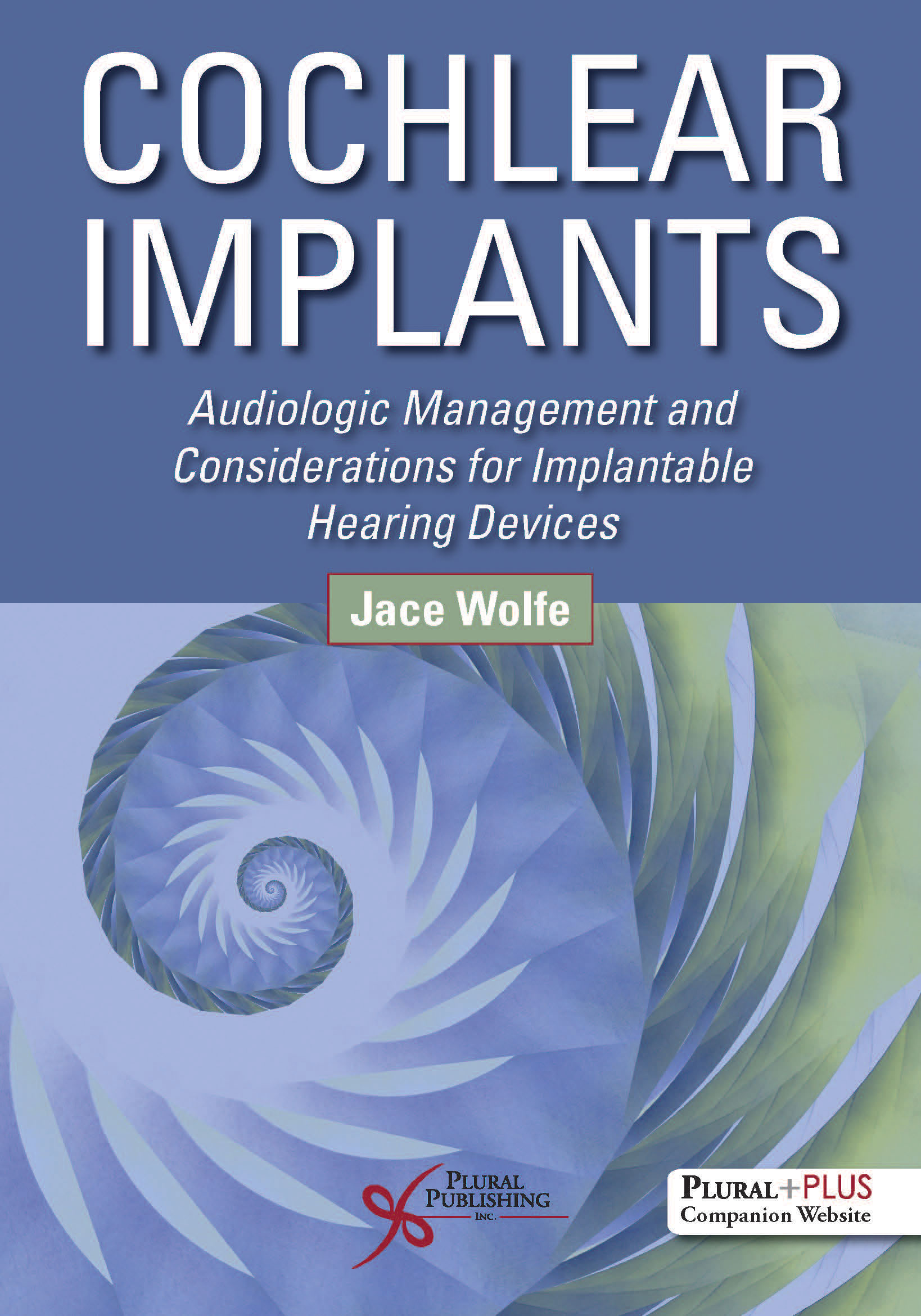
Cochlear Implants: Audiologic Management and Considerations for Implantable Hearing Devices
First Edition
Jace Wolfe
Details: 858 pages, Full Color, Hardcover, 8.5" x 11"
ISBN13: 978-1-59756-892-0
© 2020 | Available
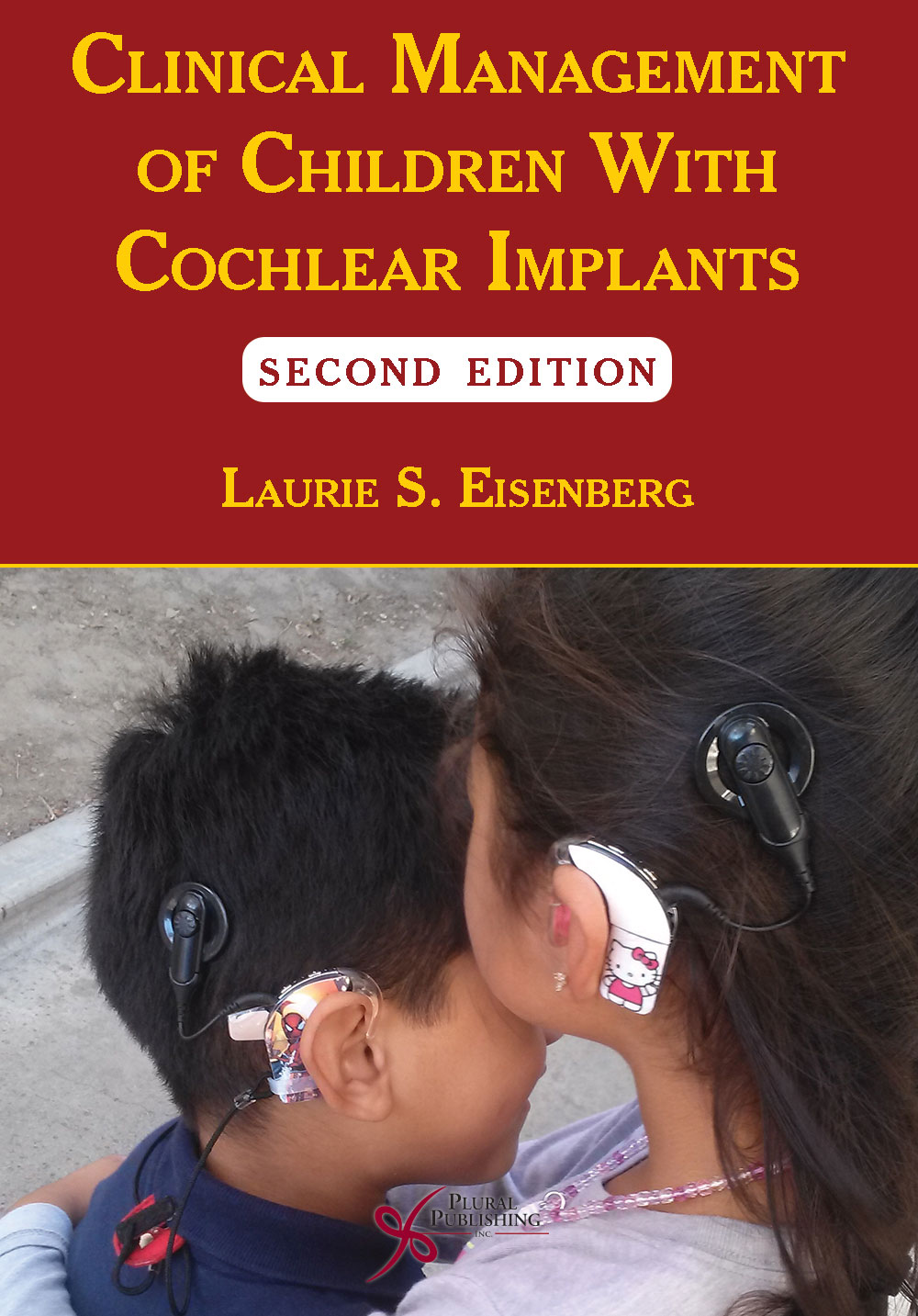
Clinical Management of Children With Cochlear Implants
Second Edition
Laurie S. Eisenberg
Details: 890 pages, B&W, Softcover, 7" x 10"
ISBN13: 978-1-59756-723-7
© 2017 | Available
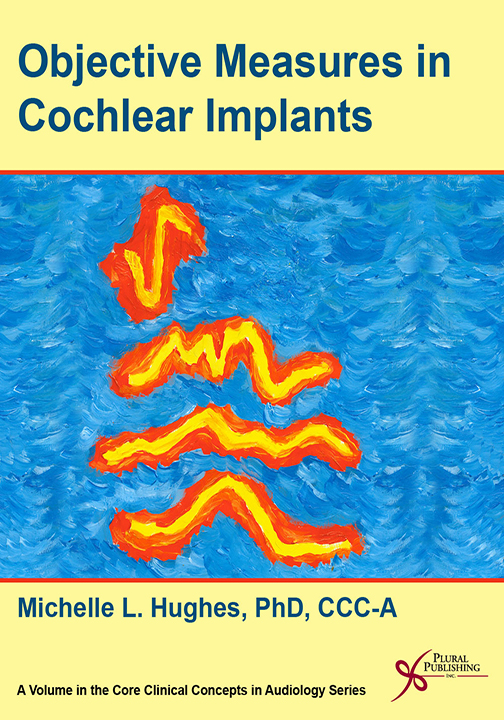
Objective Measures in Cochlear Implants
First Edition
Michelle Hughes
Details: 164 pages, B&W, Softcover, 8.5" x 11"
ISBN13: 978-1-59756-435-9
© 2013 | Available
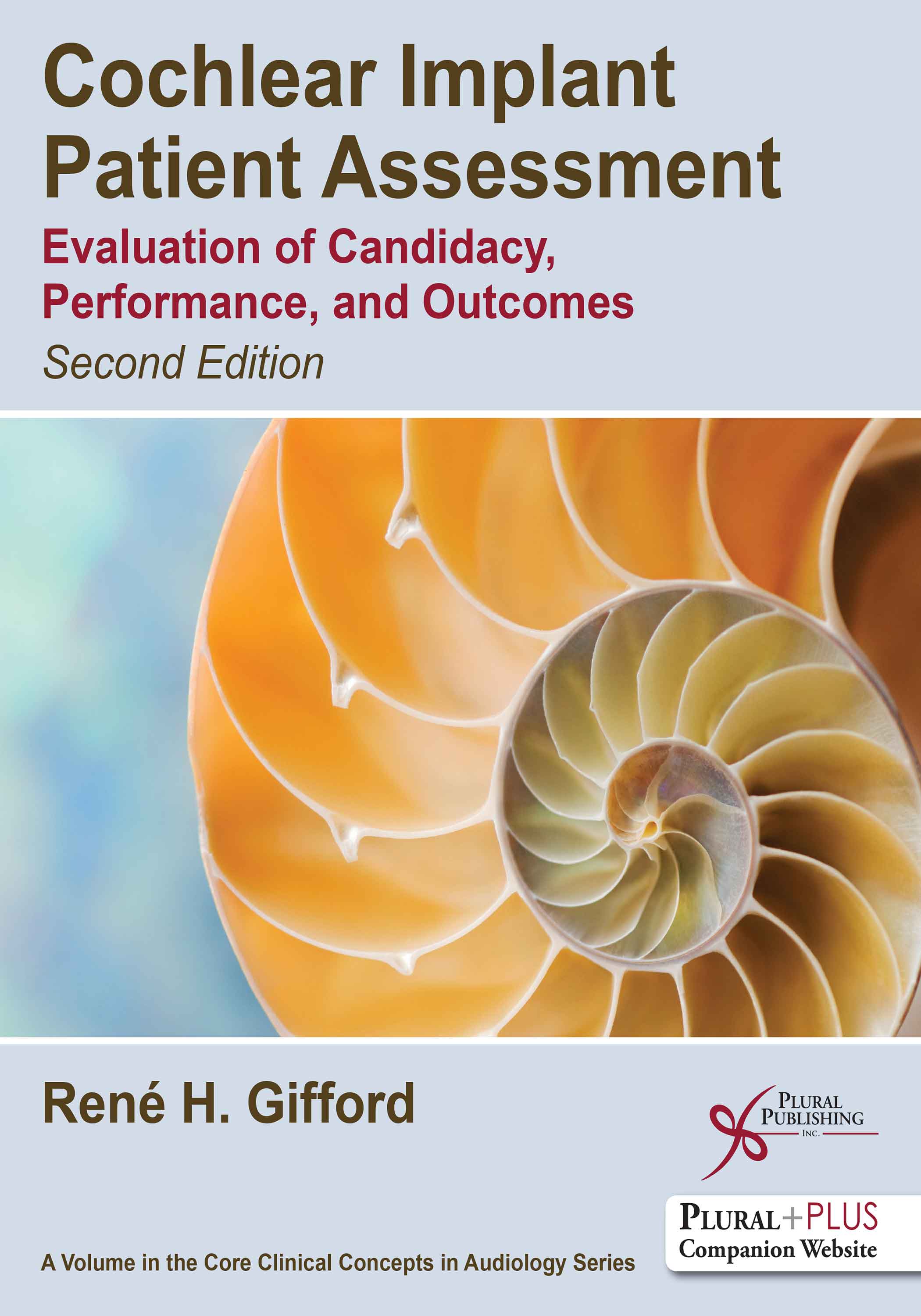
Cochlear Implant Patient Assessment: Evaluation of Candidacy, Performance, and Outcomes
Second Edition
René H. Gifford
Details: 189 pages, B&W, Softcover, 8.5" x 11"
ISBN13: 978-1-63550-128-5
© 2020 | Available
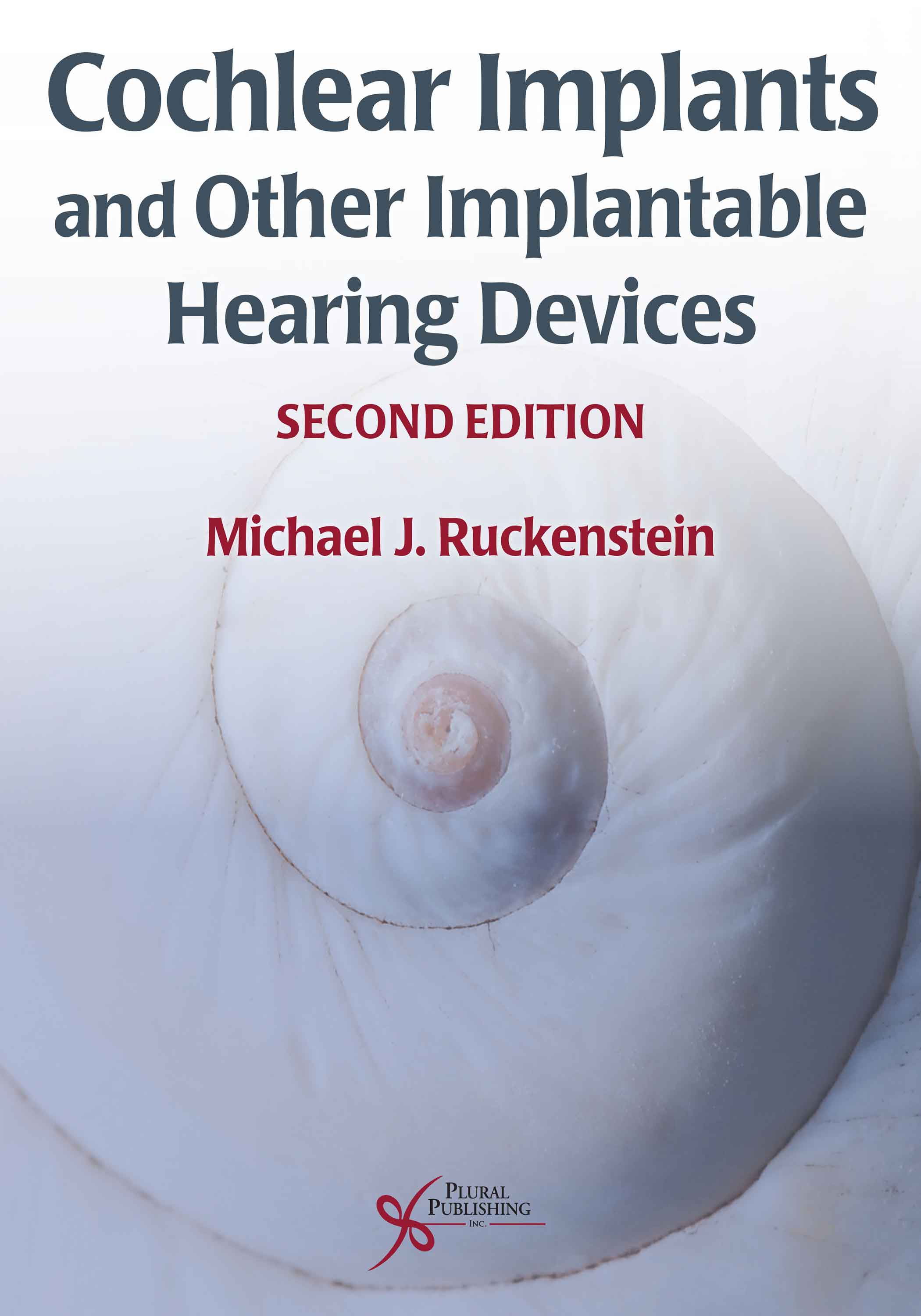
Cochlear Implants and Other Implantable Hearing Devices
Second Edition
Michael J. Ruckenstein
Details: 383 pages, Full Color, Hardcover, 8.5" x 11"
ISBN13: 978-1-63550-126-1
© 2020 | Available

Complex Cochlear Implant Cases: Management and Troubleshooting
First Edition
Joshua D. Sevier
Details: 278 Pages, B&W, Softcover, 7" x 10"
ISBN13: 978-1-63550-383-8
© 2023 | Available


